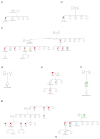Evaluation of Patients and Families With Concern for Predispositions to Hematologic Malignancies Within the Hereditary Hematologic Malignancy Clinic (HHMC)
- PMID: 27210295
- PMCID: PMC4925265
- DOI: 10.1016/j.clml.2016.04.001
Evaluation of Patients and Families With Concern for Predispositions to Hematologic Malignancies Within the Hereditary Hematologic Malignancy Clinic (HHMC)
Abstract
Introduction: Although multiple predispositions to hematologic malignancies exist, evaluations for hereditary cancer syndromes (HCS) are underperformed by most hematologist/oncologists. Criteria for initiating HCS evaluation are poorly defined, and results of genetic testing for hereditary hematologic malignancies have not been systematically reported.
Patients and methods: From April 2014 to August 2015, 67 patients were referred to the Hereditary Hematologic Malignancy Clinic (HHMC). Referral reasons included (1) bone marrow failure or myelodysplastic syndrome in patients ≤ 50 years, (2) evaluation for germ-line inheritance of identified RUNX1, GATA2, or CEBPA mutations on targeted next-generation sequencing panels, and (3) strong personal and/or family history of malignancy. Cultured skin fibroblasts were utilized for germ-line DNA in all patients with hematologic malignancy.
Results: Eight patients (12%) were clinically diagnosed with a HCS: 4 patients with RUNX1-related familial platelet disorder (FPD)/acute myeloid leukemia (AML), and 1 patient each with dyskeratosis congenita, Fanconi anemia, germ-line DDX41, and Li-Fraumeni syndrome (LFS). Two patients with concern for FPD/AML and LFS, respectively, had RUNX1 and TP53 variants of unknown significance. Additionally, 4 patients with prior HCS diagnosis (1 LFS, 3 FPD/AML) were referred for further evaluation and surveillance.
Conclusion: In this HHMC-referred hematologic malignancy cohort, HCS was confirmed in 12 patients (18%). HCS identification provides insight for improved and individualized treatment, as well as screening/surveillance opportunities for family members. The HHMC has facilitated HCS diagnosis; with increased clinical awareness of hematologic malignancy predisposition syndromes, more patients who may benefit from evaluation can be identified. Mutation panels intended for prognostication may provide increased clinical suspicion for germ-line testing.
Keywords: AML; Germ line; HCS; Inherited; MDS; Predisposition.
Copyright © 2016 Elsevier Inc. All rights reserved.
Conflict of interest statement
Figures


Similar articles
-
Hereditary myeloid malignancies.Best Pract Res Clin Haematol. 2019 Jun;32(2):163-176. doi: 10.1016/j.beha.2019.05.001. Epub 2019 May 3. Best Pract Res Clin Haematol. 2019. PMID: 31203998 Free PMC article. Review.
-
Improving the detection of patients with inherited predispositions to hematologic malignancies using next-generation sequencing-based leukemia prognostication panels.Cancer. 2018 Jul 1;124(13):2704-2713. doi: 10.1002/cncr.31331. Epub 2018 Apr 6. Cancer. 2018. PMID: 29682723 Review.
-
Hematologic malignancies and Li-Fraumeni syndrome.Cold Spring Harb Mol Case Stud. 2019 Feb 1;5(1):a003210. doi: 10.1101/mcs.a003210. Print 2019 Feb. Cold Spring Harb Mol Case Stud. 2019. PMID: 30709875 Free PMC article. Review.
-
Approach Toward Germline Predisposition Syndromes in Patients with Hematologic Malignancies.Curr Hematol Malig Rep. 2022 Dec;17(6):275-285. doi: 10.1007/s11899-022-00684-2. Epub 2022 Oct 24. Curr Hematol Malig Rep. 2022. PMID: 36279069 Review.
-
Frequency of hematologic and solid malignancies in the family history of 50 patients with acute myeloid leukemia - a single center analysis.PLoS One. 2019 Apr 18;14(4):e0215453. doi: 10.1371/journal.pone.0215453. eCollection 2019. PLoS One. 2019. PMID: 30998723 Free PMC article. Clinical Trial.
Cited by
-
Lessons From Pediatric MDS: Approaches to Germline Predisposition to Hematologic Malignancies.Front Oncol. 2022 Mar 9;12:813149. doi: 10.3389/fonc.2022.813149. eCollection 2022. Front Oncol. 2022. PMID: 35356204 Free PMC article. Review.
-
B-cell acute lymphoblastic leukemia in patients with germline RUNX1 mutations.Blood Adv. 2021 Aug 24;5(16):3199-3202. doi: 10.1182/bloodadvances.2021004653. Blood Adv. 2021. PMID: 34424323 Free PMC article.
-
Genetic variants in NHEJ1 and related DNA repair disorders: insights into phenotypic heterogeneity and links to hypoplastic myelodysplastic syndromes and familial hematological malignancies susceptibility.Ann Hematol. 2025 Mar;104(3):1633-1653. doi: 10.1007/s00277-025-06257-6. Epub 2025 Mar 6. Ann Hematol. 2025. PMID: 40047910 Free PMC article.
-
Acute Myeloid Leukemia: from Mutation Profiling to Treatment Decisions.Curr Hematol Malig Rep. 2019 Oct;14(5):386-394. doi: 10.1007/s11899-019-00535-7. Curr Hematol Malig Rep. 2019. PMID: 31350639 Review.
-
Genetic predisposition to MDS: diagnosis and management.Hematology Am Soc Hematol Educ Program. 2019 Dec 6;2019(1):110-119. doi: 10.1182/hematology.2019000021. Hematology Am Soc Hematol Educ Program. 2019. PMID: 31808839 Free PMC article.
References
-
- Garber JE, Offit K. Hereditary cancer predisposition syndromes. Journal of clinical oncology : official journal of the American Society of Clinical Oncology. 2005 Jan 10;23(2):276–92. - PubMed
-
- Ngeow J, Liu C, Zhou K, Frick KD, Matchar DB, Eng C. Detecting Germline PTEN Mutations Among At-Risk Patients With Cancer: An Age- and Sex-Specific Cost-Effectiveness Analysis. Journal of clinical oncology : official journal of the American Society of Clinical Oncology. 2015 Aug 10;33(23):2537–44. - PMC - PubMed
-
- Alter BP. Cancer in Fanconi anemia, 1927–2001. Cancer. 2003 Jan 15;97(2):425–40. - PubMed
Publication types
MeSH terms
Substances
Grants and funding
LinkOut - more resources
Full Text Sources
Other Literature Sources
Medical
Research Materials
Miscellaneous

